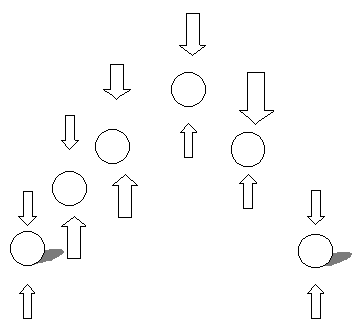
Forces
This block will introduce balanced and unbalanced forces. These forces are around us and we take many of them for granted. We don't even realise that they are there and so it comes as a surprise to try and work with them.
We are going to introduce many terms and some may seem confusing. Don't worry we will explain them and make it easier to understand them.
When we are describing forces we are concerned with two things:
1. Direction of the force
2. The size of the force.
We can show forces by using arrows (they are easy to draw and give lots of information about the force).
Look below at some examples.

Here is a ball. There are 2 forces acting on the ball. Just by looking at the arrows can you tell if it is moving or still. If you think it is moving which direction would you say?
Go to answer
Answer
The ball is moving to the right.
The biggest arrow is pointing to the right and a smaller arrow is pointing to the
left.
If you wanted to show that the ball was still, What do you think the arrows would look like?
![]()
This shows that the two forces are equal. There is as much force from the left as there is from the right.
These forces are BALANCED. This means that the object is either still (at rest) or moving at constant
speed.
Constant speed?
This seems tricky. I will try and explain.
Think of travelling in a car.
1. The car is at rest (still)

What are the forces on the car (we have left out gravity for the
moment).
Where do you think the size and direction of the arrows will be?

Both arrows are equal size and opposite in direction.
The forces are balanced.
2. Now you want the car to move forward by pressing on the accelerator and providing power to the wheels to get the car moving.
What do the arrows look like now?

Now the forces are unbalanced (the car is accelerating to the right)
3. You get to 60miles per hour and you don't want to go any faster. You want to keep going at the same speed (60 miles per hour).
You have to keep the engine going by pressing the accelerator pedal (but not too far).
What happens to the arrows now?
Go to answer

That's right, the arrows are the same size (the forces are balanced again. You must keep the accelerator pressed, though).
What happens if you take your foot off the accelerator? You are going to slow down. How will you show this with arrows?

That's right the arrow on the right is bigger than the arrow on the left. This shows that the force from the right is greater than the force from the left so the car will slow down and eventually stop.
We know how to show that with arrows don't we?
But what can we say about the forces when the car is still (at rest)?
Go to answer

The forces are balanced. The arrows are equal and opposite.
Review
So far we have looked at forces. We have not talked about what those forces are. We are only discussing the size and direction of forces at the moment.
Forces can be balanced or unbalanced.
Balanced forces mean that an object is either still (at rest) or moving with constant (the same) speed. The forces are equal but opposite.
Unbalanced forces means that an object is speeding up or slowing down. The forces are not equal.
Unbalanced forces change an object's speed shape or direction.
Think of throwing a ball up in the air. Here are the forces acting on the ball
Here is a picture of the ball going up and coming back down. Look at the forces. Does this picture make sense to you
now?
1. The ball is at rest;
2. The ball accelerates upwards;
3. The ball is slowing down;
4. The ball starts to move back down;
5. The ball lands and is at rest again.

This can look hard but it really is easy and after we have covered this block you will wonder what was hard about it.
Well that is enough for today.
Remember
Forces can be balanced or unbalanced.
Balanced forces mean that an object is either still (at rest) or moving with constant (the same) speed. The forces are equal but opposite.
Unbalanced forces means that an object is speeding up or slowing down. The forces are not equal.
Unbalanced forces change an objects speed shape or direction.
We show forces by arrows. The size and direction of the arrows shows the size and direction of the force.
Next time we will look at the force of friction.